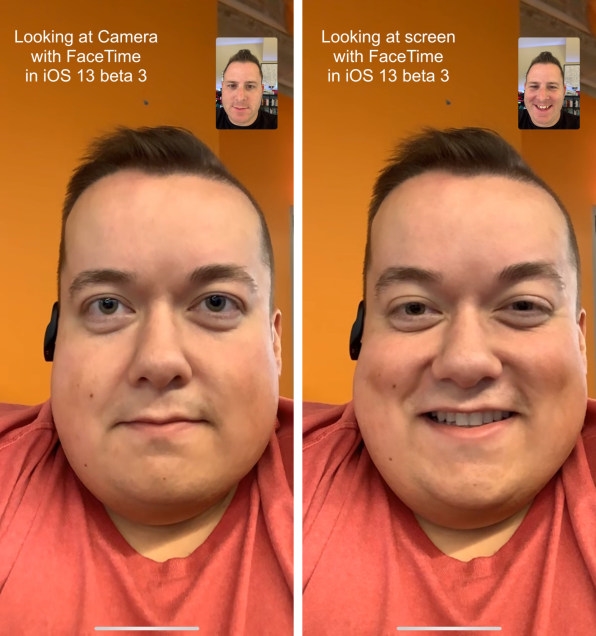The eyes are the windows to the soul. But in iOS 13, that soul can be faked.
For years, FaceTime has been the most intimate way to talk to someone digitally—providing a face-to-face experience that the app is named after. But it’s always been imperfect, too. Because the phone’s camera is not literally inside the other person’s eyes (as it is in real life!), you can’t make real eye contact. FaceTiming can feel a bit like two people are talking while checking their email.
Now, Apple is simulating eye contact in FaceTime with digital fakery. App designer Mike Rundle noticed a new feature in iOS 13’s third developer beta called FaceTime Attention Correction. Working on the iPhone XS and XS Max, the system appears to use ARCore—the same tech behind animoji—to fix the position of your pupils digitally. That means FaceTime is using image manipulation to fake eye contact (though the feature can be toggled on or off).
It’s a technical marvel, but it’s also an unsettling confirmation that the post-reality age is officially here.

One special effects expert described this new era to me as “a war on what’s real.” The age of Photoshop, which required a certain amount of skill and practice to manipulate imagery convincingly, has been quickly surpassed by simpler interfaces and vastly more powerful artificial intelligence. Case in point: a new app called DeepNude—which was quickly unpublished—allowed users to literally turn any image of a woman into an image of that woman naked. All you needed was their (clothed) photo. Automation did the rest.
The smartphone industry has become an arms race focused on the camera (Apple had a reported 800 employees working on the iPhone camera alone). The best features of these cameras rely on a certain amount of digital fakery. Smartphones these days regularly combine the darkest and brightest parts of one or multiple pictures to create those impossible looking “HDR” or “High Dynamic Range” images that just seem to pop off your screen. Google’s Pixel camera even uses this technique to turn pitch black frames into highly detailed images. It’s “faked,” sure, but in a sense, these moments still happened, albeit a pixel or two at a time, glued together.
Other recent tools have gone a step beyond HDR. For instance, Apple’s Portrait Mode (and a similar feature on the Pixel) isolates a figure in a frame, then blurs the background, to simulate a finer lens. What that really means is that your phone’s software is essentially green-screening your loved ones. I get it—many people love this feature because it allows you to focus on a subject, not the background. Yet still, on some level, it makes my stomach churn: it means the software on our phones is inventing pixels when it couldn’t capture them. What it couldn’t do in the analog world it just faked in the digital one. And that’s a slippery slope.
Guys – “FaceTime Attention Correction” in iOS 13 beta 3 is wild.
Here are some comparison photos featuring @flyosity: https://t.co/HxHhVONsi1 pic.twitter.com/jKK41L5ucI
— Will Sigmon (@WSig) July 2, 2019
In its new iOS 13 update to FaceTime, Apple is experimenting with faking eye contact, or our “attention” in the company’s own language, in real time, face-to-face conversations. This feature is not unsettling for where it may go one day; it is unsettling for what it represents right now. Your eyes are just an AI—the part you literally look at when you talk to someone is not actually them anymore.
For years, companies have been working on fitting a camera behind the screen to solve the eye-contact issue with video chatting. Samsung recently applied for a patent on such a technology. This would be a one alternative way to solve Apple’s problem: to actually position a camera so that we could look at the screen, the camera, and the other person’s eyes at the same time. But the truth seems to be increasingly less important in a world where software can easily and realistically mimic our faces and expressions.
Apple is not the only company experimenting in this space, of course. Image manipulation has been driven by independent software developers and big companies alike. Still, FaceTime’s fake eyes are the flag bearer of a new reality. It’s a place where even face-to-face conversations with your children are a little bit fake.
Fast Company , Read Full Story
(67)